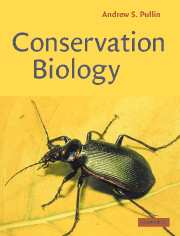Book contents
- Frontmatter
- Contents
- Preface
- Part 1
- Part 2
- Part 3
- Chapter 7 The rise of conservation biology
- Chapter 8 Selecting protected areas
- Chapter 9 Design and management of protected areas
- Chapter 10 Protecting species. I. In situ conservation
- Chapter 11 Protecting species. II. Ex situ conservation and reintroduction
- Chapter 12 Landscape scale conservation
- Chapter 13 Conserving the evolutionary process (a longer-term view of conservation)
- Chapter 14 Ecological restoration
- Chapter 15 Putting the science in to practice
- References
- Index
Chapter 10 - Protecting species. I. In situ conservation
Published online by Cambridge University Press: 05 June 2012
- Frontmatter
- Contents
- Preface
- Part 1
- Part 2
- Part 3
- Chapter 7 The rise of conservation biology
- Chapter 8 Selecting protected areas
- Chapter 9 Design and management of protected areas
- Chapter 10 Protecting species. I. In situ conservation
- Chapter 11 Protecting species. II. Ex situ conservation and reintroduction
- Chapter 12 Landscape scale conservation
- Chapter 13 Conserving the evolutionary process (a longer-term view of conservation)
- Chapter 14 Ecological restoration
- Chapter 15 Putting the science in to practice
- References
- Index
Summary
Much of our current conservation activity is directed towards individual species that have come under threat for the range of reasons described in earlier chapters. Species naturally forma focus for conservation because they are recognisable units whose loss can be quantified, but more importantly because the public can relate to species in a more direct way than to ecosystems or to genes. In this chapter we look at how threat to individual species can be assessed and how the theoretical tools of population dynamics and population genetics can be used in the management of threatened species and their populations.
By reading this chapter students will gain an understanding of the basis of assessing threat to species and the system of categorisation, methods of managing species and their constituent small populations so as to minimise the threat of their extinction, and efforts towards the sustainable harvesting of species that are directly exploited.
Commoness and rarity among species
The science of ecology has given us many studies pointing towards an intimate link between species and their habitats. It is evident that species have become adapted through the process of evolution to persist within a restricted range of environmental parameters and many are highly specialised and vulnerable to environmental change. Over time, gene pools track their ever-changing environmental template, some genes becoming rarer or even disappearing, whilst others arise through mutation and may become common in a population.
- Type
- Chapter
- Information
- Conservation Biology , pp. 199 - 226Publisher: Cambridge University PressPrint publication year: 2002

